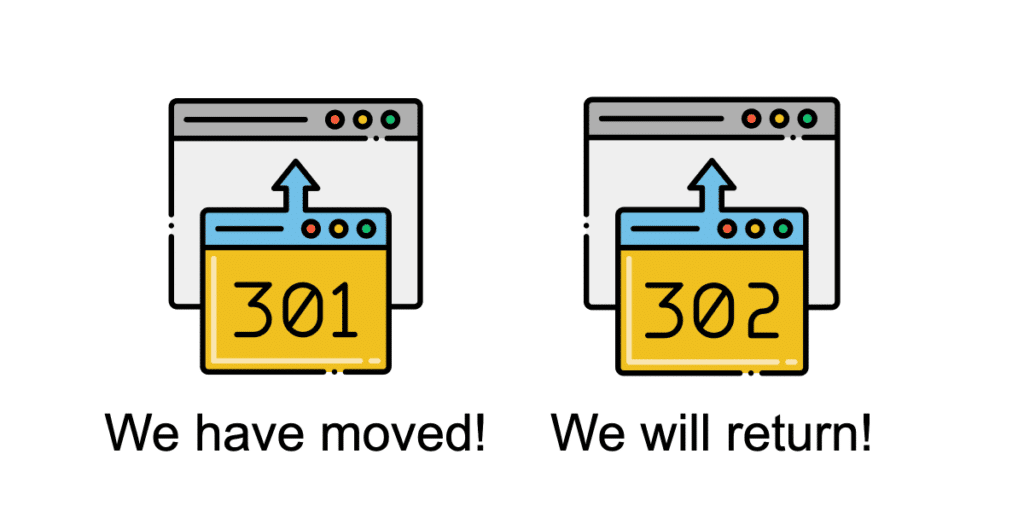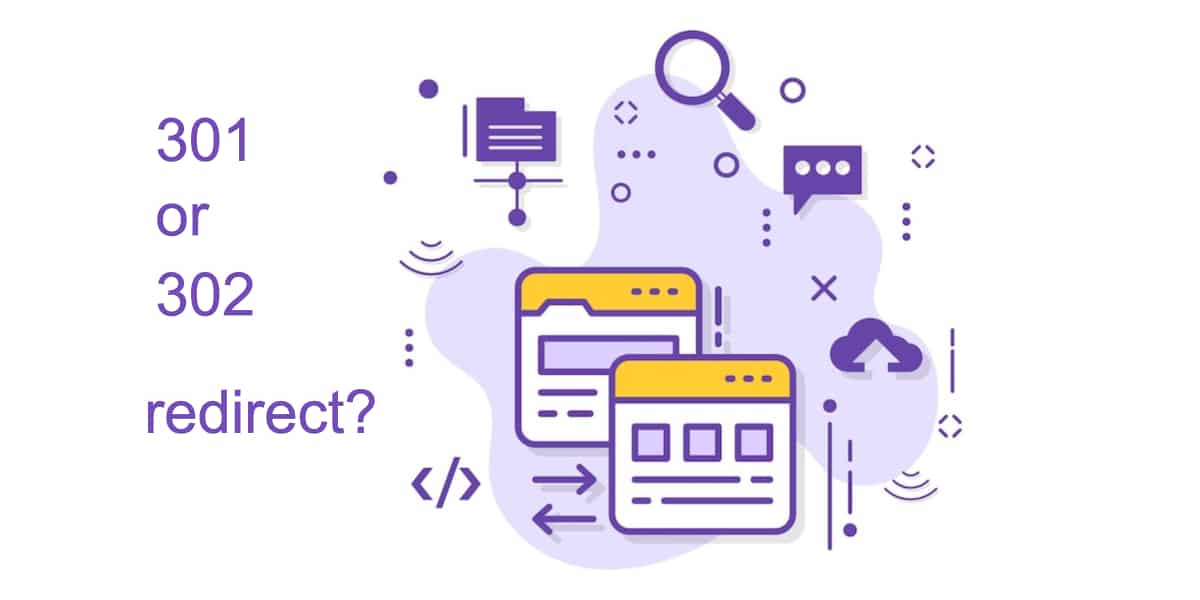It is important to know the differences between 301 and 302 and what they are for before redirecting your links. If you do not know the differences between the two, this article is for you.
What is a 301 redirect for?
Search engines and visitors can be directed to the proper location by employing a 301 redirect. When a page has been permanently relocated, the server returns a 301 status code.
The previous page has been replaced with the new one, so users will immediately notice the change. If you do this, the URL that appears in search engine results will shift.
The .htaccess file is only accessible from within the server. Thus developers and owners of websites hosted on Apache servers must access the server. Find out additional information from your hosting firm if your website is hosted on a server with different software.
When should you use a 301 redirect?
With a 301 redirect, the old page is deleted, and the new one is displayed in search engine results. You should do this if you want the URL redirecting to the new page for at least a year. All the link juice is sent to the new page using this redirect form.
example.com that redirects to www.example.com is a basic example of a 301 redirect; when a page has moved permanently, it never links to the old address.
Hence, redirecting with a 301 status code is permanent. Temporary adjustments or A/B tests cannot benefit from this. Here are some cases wherein you should use a 301:
- You want outdated links to be sent to your target page. For instance, you are permanently transferring a webpage/s.
- Many different web addresses point to yours. Choose one URL to serve as the canonical and preferred destination, and then use 301 redirects to send visitors to either the old URL or the new one.
- You’ve just switched to a new domain name and want everything to go off without a hitch for your visitors.
- You’re switching your site from the HTTP protocol to the HTTPS protocol.
What is a 302 redirect for?
Users and search engines are sent to the requested page for a short period using a 302 redirect, after which the redirect is withdrawn. The status code could change to 302 Found (HTTP 1.1), or it could be temporarily relocated (HTTP 1.0). Instead of reading server files and wasting the extra time and effort needed for a 301 redirect, a 302 redirect can be done with a meta tag or JavaScript.
Some webmasters choose to utilize 302 redirects rather than the more common 301. Some webmasters choose not to use 301 redirects in the hopes of avoiding the age penalty imposed by Google.
Since Google’s goal is to provide a better search engine experience, and since web admins frequently utilize a 302 redirect when a 301 redirect would be more appropriate due to a lack of knowledge on the subject, this creates a problem for Google.
This can impact search engine rankings and other metrics negatively. This can lead to issues like the previous URL still being indexed by search engines and the URLs competing with each other.
When should you use a 302 redirect?
A 302 redirect can be helpful in some situations. Here are some instances when you should use a 302 redirect:
- This method can put website usability and aesthetics through a series of A/B tests.
- Garnering client comments on a brand-new page without a drop in search engine rankings.
- Maintaining a consistent user experience across multiple versions of a website.
- The website is down, but you still want to provide a positive experience for visitors in the meantime.
- You want to gauge user experience and collect data. However, you should not rely on redirects as a long-term fix.
Differences between 301 and 302 Redirects

In most cases, web admins will utilize a 302 redirect instead of a 301 redirect, which might lead to complications. When both choices result in the relevant page, the user’s search experience may be identical.
A 302 redirect indicates a temporary page relocation, while a 301 redirect indicates a new page has permanently replaced the old one in the eyes of search engines.
Perhaps it’s up to your site to determine if someone accidentally used one. Misdirecting visitors to the wrong page(s) might result in a significant drop in site traffic. To improve your website’s search engine optimization (SEO), you should be familiar with the distinction between 301 and 302 redirects.
Differences between 301 and 302 redirects in Google’s perspective
Since both 301 and 302 redirects achieve the same result for the user, the difference between them lies in how Google interprets them. And there are two topics that require discussion– indexing and link signals
Indexation
301 redirects
When a redirect occurs, the 301 redirected URLs are removed from Google’s index. If you’re using 301 redirects, ensure that address is now the “new” one. If you have two HTML files named old-page.html and new-page.html and set up a 301 redirect, Google will only index the latter and ignore the former.
A 301 redirect notifies search engines that the destination URL has changed permanently, so they need not continue to index the previous location.
It’s easy to confuse this because Google’s site: searches may continue to return the old URL for some time after a 301 redirect has been set up.
302 redirects
Google will most often continue to index the original URL. However, Google evaluates every 302 redirects individually to discover what you truly meant because they know people frequently use them for permanent redirects by accident. Google appears to treat 302s as 301s in some cases initially.
The amount of time a 302 redirect must be in place before Google treats it as a permanent redirect is unknown. It’s usually a couple of weeks, but it may be a few days, weeks, or months.
Link signals
In the past, 3XX redirects on links would degrade PageRank, but as of 2016, this is no longer the case.
30x redirects don’t lose PageRank anymore.
— Gary 鯨理/경리 Illyes (@methode) July 26, 2016
When you redirect a URL, all the link juice goes to the new location. Yet its operation is frequently misinterpreted, as the location of signal consolidation can be affected by the type of redirect.
301 redirects
The ‘forward’ signals of linked resources are consolidated and sent to the ‘new’ URL.
If you have 10 links pointing to old-page.html and 301, redirect it to new-page.html, and all of the link juice will flow to the latter. In other words, new-page.html should be treated as though it had ten links by Google. The problem is that Google considers irrelevant redirection “soft 404s,” so it’s not quite easy.
302 redirects
Link signals often converge “backward” to the “old” URL for 302 redirects. For instance, if you 302 redirect old-page.html to new-page.html and new-page.html has 10 backlinks, all the link signals will typically concentrate on old-page.html. As such, Google’s algorithm should evaluate old-page.html as if ten different pages are linked to it.
On the other hand, the reality isn’t quite so straightforward. How Google handles the 302 redirects is a key factor.
It is true that link signals will accumulate backward if users consider this a temporary redirect. However, this assumes that the destination page is the same as or very comparable to the “new” page. A soft 404 could be considered if not.
Forward consolidation of link signals is expected if they treat the reroute as permanent. Google’s URL Inspection tool lets you see how the search engine handles a reroute. Just enter the “new” redirected URL in its place.
In cases where “Inspected URL” appears under “Google-selected canonical,” a temporary redirect is processed by Google. When not qualified as temporary, it is treated as such.
A guide to creating redirects
There are a few different ways to set up redirects with the 301 and 302 codes, but the most frequent is to change the .htaccess file of the website in question. It is the case that this file is located in the root directory of your website.
Notes:
If you’re using Apache, you may fix the issue by creating a.htaccess file with a text editor like Notepad and then uploading it to the root server. Using a free SEO plugin to establish redirects in WordPress is a less scary alternative. Although RankMath already includes this feature, our plugin will accomplish the same.
How to make a 301 redirect
You can make a permanent redirection from one URL to another by inserting the following into your .htaccess file:
Redirect 301 /old-page.html /new-page.html.The RankMath or Redirections add-ons can also be used for this purpose. Pick a redirect type, then enter the original and new URLs.
Including this in your .htaccess file will reroute the entire website.
RewriteEngine on
RewriteCond %{HTTP_HOST} ^oldsite.com [NC,OR]
RewriteCond %{HTTP_HOST} ^www.oldsite.com [NC]
RewriteRule ^(.*)
$ https://newsite.com/$1 [L,R=301,NC]How to make a 302 redirect
It is possible to establish a 302 redirect by inserting the following into yours. htaccess file:
Redirect 302 /old-page.html /new-page.html.
Both RankMath and the WordPress Redirections plugin allow you to accomplish this.
To perform a site-wide redirect, use the following code:
RewriteEngine on
RewriteCond %{HTTP_HOST} ^oldsite.com [NC,OR]
RewriteCond %{HTTP_HOST} ^www.oldsite.com [NC]
RewriteRule ^(.*)
$ https://newsite.com/$1 [L,R=302,NC]The SEO Implications of 301 and 302 Redirects
How would employing 301 and 302 redirects affect your “link juice?” According to a video posted by Matt Cutts, using 301 redirects will not result in a decrease in link authority.
Critics assert that a 301 redirect can waste 15% of a site’s “link juice,” but a 302 redirect shouldn’t affect metrics like PageRank, Domain Authority, or Traffic Value. Accidentally using a 302 redirect might lead to user confusion and lower rankings in search engines.
There is a specific function for each reroute. A 301 redirect is a permanent redirect that is recognized by search engines. Unless the change is temporary, you shouldn’t use a 302 redirect, but it’s more convenient to set up than a 301 redirect.
Recognizing when and how to employ redirects is crucial. There are several contexts in which web developers and managers implement new pages or relocate existing ones.
Frequently asked questions
What is the optimal length of a redirect?
It’s unclear how long a 301 redirect actually lasts. When should you stop the redirect?
In light of this issue, Google’s John Mueller advised that permanent 301 redirects should be implemented. So that we can be certain that all of the old URLs have been replaced with the new ones, “that could be something perhaps a year, or preferably even longer than a year.”
Google needs time to finish indexing the old page and redirecting all of its links to the new one, so it is crucial that the redirect be left in place permanently. If you have bookmarked the old page, please update your bookmarks to go to the new location. If you disable the redirect and someone still tries to access the previous website, they will receive a 404 error.
Google doesn’t insist that the redirect be permanent because it knows that domains can expire or be acquired and redirected to other sites.
For “minor” redirects, such as when you only want to change a subdomain or subfolder of a URL while preserving the main domain name, you can leave the redirect in place indefinitely without any problems. As a result, there is no cost or server load involved.
If you’re making a major change like switching your domain name, Google suggests leaving a redirect in place for a full year. Start analyzing your server logs once a year has passed.
Find out where the traffic is coming from and if it is still being diverted from the old URL to the new one. It might be anything, from visitors who have bookmarked a page to outdated links that are still live.
First, you should discover where the redirect is coming from and, if possible, take measures to redirect the source to the correct URL. The redirect can remain active forever if you continue paying for the old domain name.
Do you need to “repair” 302 redirects that were made inadvertently?
The solution will depend on how Google currently handles the redirects.
Changing the ‘accidental’ 302s to 301s might not affect the movers who have already decided to relocate permanently. They should probably change the redirects from 302s to 301s if they haven’t already done so.
Using the GSC URL Inspection tool, you can see exactly how Google handles specific URLs, as demonstrated above. But if you have several reroutes, that can take a long time. The process can be sped up by looking for 302 redirects that are already receiving organic traffic initially. After all, that’s clear evidence that Google hasn’t given up on the temporary nature of the reroute.
Bottomline
It’s not hard to set up a redirect. The usage of a 301 redirect is recommended when relocating content permanently. Use a 302 redirect if the location is changing temporarily.
If you make the mistake of using the wrong type of redirect, take comfort that Google will probably figure out what you meant. While Google is getting smarter, it’s still important to utilize the appropriate form of redirect wherever possible.




